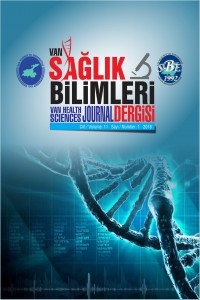RESVERATRO L ve COQ10’in FOTON ZAYIFLATMA KARAKTERİSTİKLERİ
Bu araştırmada, antioksidanlar ile ele ktro manyetik radyasyon etkileşim
olasılığını karakterize eden bir dizi katsayı hesaplanmıştır. Bu amaçla, WinXCom
bilgisayar programı 1
ke V'den 100 Ge V'ye kadar enerjilerde çalıştırıldı. Etkin atom
sayısı ve elektron yoğunlukları, antioksidanların kütle zayıflama
katsayıları ku llan ıla
rak hesaplandı. Son olarak, µρ değerlerinin farklı
etkileşim mekanizmaları nedeniylegama enerjisinin
artmasıyla azaldığı ve
incelenen parametrelerin gelen foton enerjisi ve antioksidanın kimyasal bileşimine bağlı olarak
değiştiği bulundu. Hesaplanan değerler
birbiriyle karşılaştırıldı.
Anahtar Kelimeler:
CoQ10, reveratrol, etkin atom sayısı, elektron yoğunlukları
PHOTON ATTENUATION CHARACTERISTICS of CoQ10 and RESVERATROL
In this
research, a number of coefficients,
which characterize the probability of electromagnetic radiation interaction with the
antioxidants, have been
calculated. For this purpose, WinXCom
computer program was run at energies
from 1 ke V to 100 Ge V. The
effective atomic numbers and
electron densities were
calculated using the mass attenuation coefficients of antioxidant. Finally, it was found
that the values of µρ decreased with increasing
gamma energy by means of different
interaction mechanism and the values of
investigated parameters were found to be changed
with the incoming photon energy and
chemical content of the antioxidants
The calculated values were compared
with each other.
Keywords:
CoQ10, Resveratrol, Effective atomic number, Electron densities,
___
- Gerward L, Guilbert N, Jensen KB, Levring H. X-ray absorption in the matter . Reengineering XCOM. Radiat Phys Chem, 2001; 60: 23- 24.
- Gerward L, Guilbert NK, Jensen B, Levring H. WinXCom-a program for calculating X-r ay attenuation coefficients. Radiat Phys Chem. 2004; 71 (3): 653-654.
- Gowda S, Krishnaveni S, Gowda R. Studies on effective atomic numbers and electron densities in amino acids and sugars in the energy range 30-1333 keV. Nucl Instrum Meth B. 2005, 239 (4), 361–369.
- Isıklı Z, Oto B. Gamma or X-rays attenuation properties of some biochemical compounds. Rad Effects Defects Solids, 2017; 172 (3-4): 296- 304.
- Jay achandr an CA. Calculat ed effective atomic number and kerma values for tissue- equivalent and dosimetry materials. Phys Med Biol, 1971; 16 (4): 617.
- Kovacs E, Keresztes A. Effect of gamma and UV-B/C radiat ion on plant cells. M icron, 2002; 33 (2): 199-210.
- Manohara S.; Hanagodimath S, Gerward L. Studies on effective atomic number, electron density and kerma for some fatty acids and carbohydrates. Phys Med Biol, 2008; 53 (20): 377-386.
- Manohara SR, Hanagodimath SM and Gerward L. The effective atomic numbers of some biomolecules calculated by two methods: A comparative study. Med Phys, 2009; 36 (1):137-141.
- Muta-Takada K, Terada T, Yamanis hi H, Ashida Y, Inomata S, Nishiyama T et al. Coenzyme Q10 protects against oxidative stress-induced cell death and enhances the synthesis of basement membrane components in dermal and epidermal cells. Biofactors. 2009; 35(5): 435–441.
- Rao BT, Raju MLN, Narasimham KL, Parthasaradhi K, Rao BM. Interaction of low- energy photons with biological materials and the effective atomic number. Med Phys 1985; 12(6): 745-748.
- Sayyed MI, Issa SA and Auda SH . Assessment of radio- protective properties of some anti-inflammatory drugs. Prog Nuc Ener , 2017; 100: 297- 308.
- Talevi R, Barbato V, Fiorentino I, Braun S, Longobardi S, Gualtieri R.Protective effects of in vitro treatment with zinc, d-aspartate and coenzyme q10 on human sperm motility, lipid peroxidation and DNA fragmentation. Reprod Bio l Endocrinol. 2013; 16: 11:81
- Truong VL, Jun M and Jeong WS.Role of r esveratrol in regulation of cellular defense systems against oxidative stress.Biofactors, 2018; 44 (1): 36- 49. Yang NC, L eic hner PK, Hawkins WG. Effective atomic numbers for low energy total photon interactions in human tissues. Med Phys. 1987; 14 (5): 759-766.
- ISSN: 2667-5072
- Başlangıç: 2018
- Yayıncı: Van Yüzüncü Yıl Üniversitesi
Sayıdaki Diğer Makaleler
OMUZ ÇIKIĞINDA GÜVENİLİR ETKİN VE BASİT BİR YÖNTEM: SPASO TEKNİĞİ
VAN İLİ ÖZALP İLÇESİNDE ÇOCUKLARDA Pediculus humanus capitis’in YAYGINLIĞI
Ali Rıza KUL, Veysel BENEK, Sema KAPTANOĞLU, Salih ALKAN, Vedat AVCI
RESVERATRO L ve COQ10’in FOTON ZAYIFLATMA KARAKTERİSTİKLERİ
GLİOBLASTOMA’da 5-FU ve CELASTROL’ün SİTOTOKSİK ETKİSİ
Mehmet TAŞPINAR, Farika Nur DENİZLER, Mustafa GÜVEN, Veysel YÜKSEK, Sedat ÇETİN, Semiha DEDE
OMUZ İMPİNGEMENT SENDROMU ve ROTATOR CUFF CERRAHİSİNDE ORTA DÖN EM SON UÇLARI
